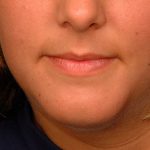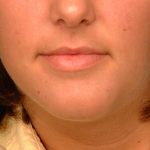Occipital plagiocephaly is a well known congenital malformation of the back of the head marked by an oblique slant to the main axis of the skull. It is commonly corrected today by the early institution of either static or dynamic cranial orthotics or helmets. In rare cases if the skull is significantly deformed and does not respond to external molding influences, cranial reshaping can be successfully done.
Plagiocephaly is well known to affect how the face develops. What happens in the back of the skull will influence how the front of the skull and face looks. This occurs in a diametrically opposite manner. The side that is flat on the back of the head will be protrusive on the front and vice versa. Even in cases where helmet therapy or even surgery has made a well rounded back of the head, the face may still show some of the residual effects as it develops resulting in facial asymmetry. When plagiocephaly goes untreated or was not adequately treated at a young age, this facial asymmetry may become quite apparent.
The facial asymmetry that results from a plagiocephalic influence appears as that of a ‘twisted’ face if one is looking from above. This is apparent by misaligned ears (the ear on the affected side may be pulled forward and down and be larger then the unaffected ear) and facial asymmetry, with the more forward side of the face having a fuller forehead, brow bone, and cheek. The jawbone will be tilted and one’s occlusion (bite) may have a cant to it. There may be differences in the position and shape of the jaw angles and the chin may be deviated toward the weaker or more retrusive side.
When the facial asymmetry is very severe, complete facial bone repositioning incorporating orthodontics and multiple jaw orthognathic surgery is needed. But most of such facial asymmetry that I see in my Indianapolis plastic surgery practice is more mild and in late adolescence or adulthood. Patients are looking for less major methods for improving their facial asymmetry.
When one considers improving facial asymmetry, a careful analysis of the face must be done to determine exactly where the imbalances are. Of even greater importance is input from the patient as to which facial prominences they consider to be the good or the bad side. This is very important because weak areas can be built up with implants which is most commonly done because it is easier. But reduction of bone can be done in certain facial areas if they are too prominent.

While complete or perfect facial symmetry is not obtainable in any case, significant camouflaging of the facial bony asymmetries can be made. Such surgical improvement provides great psychological relief to the facial asymmetry patient and can usually be achieved in a single operation.
Dr. Barry Eppley
Indianapolis, Indiana



